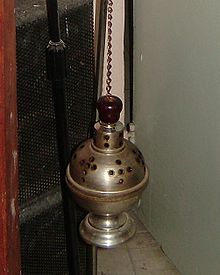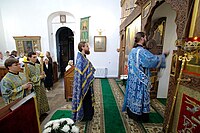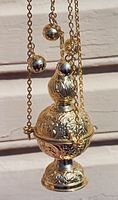Thurible
|
Read other articles:

Bahasa Pamona Bare’e Dituturkan diIndonesiaWilayahSulawesi (Sulawesi Tengah, Sulawesi Selatan)EtnisPamonaPenutur140.000 (2000) Rincian data penutur Jumlah penutur beserta (jika ada) metode pengambilan, jenis, tanggal, dan tempat.[1] 137.000 (2000) Rumpun bahasaAustronesia Melayu-PolinesiaMelayu-Polinesia IntiCelebikKaili-PamonaUtaraPamona DialekPamona Selatan (Pu'umboto) Pamona Tengah (Danau Poso) Pamona Timur Pamona Utara (Pantai Bare'e, Poso Pesisir) Kode bahasaISO 639-3pmf…

This article relies largely or entirely on a single source. Relevant discussion may be found on the talk page. Please help improve this article by introducing citations to additional sources.Find sources: Forestry in Sudan – news · newspapers · books · scholar · JSTOR (October 2020) Forestry in Sudan includes both traditional gatherers of firewood and producers of charcoal—the main sources of fuel for homes and some industries—and a modern timber and …

U.S. healthcare company Merative L.P.Company typePrivatePredecessorIBM Watson HealthFoundedJune 30, 2022; 22 months ago (2022-06-30)HeadquartersAnn Arbor, MichiganKey peopleGerry McCarthy (CEO)OwnerFrancisco PartnersNumber of employees1,000–5,000Websitemerative.com Merative L.P., formerly IBM Watson Health, is an American medical technology company that provides products and services that help clients facilitate medical research, clinical research, real world evidence, and he…
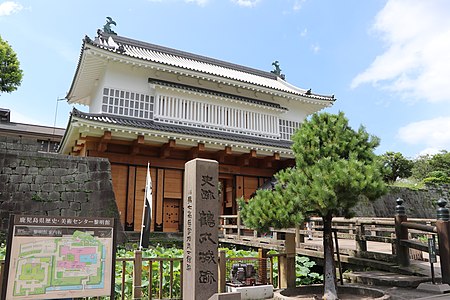
薩摩藩 ← ← ← ← 1600年 - 1871年 → → → (島津氏家紋『丸に十文字』) 公用語 日本語薩隅方言 首都 鹿児島 藩主 1601年 - 1638年 島津家久 1858年 - 1871年島津忠義 変遷 成立 1600年 廃藩1871年 通貨三貨 現在 日本国 鹿児島県 宮崎県 沖縄県 この項目に含まれる文字「薩」は、オペレーティングシステムやブラウザなどの環境により表示が異なります。 「薩」�…

Questa voce o sezione sull'argomento meccanica non cita le fonti necessarie o quelle presenti sono insufficienti. Puoi migliorare questa voce aggiungendo citazioni da fonti attendibili secondo le linee guida sull'uso delle fonti. Il cambio (o cambio di velocità) è un componente meccanico che ha la funzione di modificare la caratteristica della coppia motrice di un motore, similmente ad un riduttore di velocità. Inoltre permette di selezionare di volta in volta un rapporto di trasmissione…

Protected public forest in Mendocino County, California, US Jackson Demonstration State ForestWestern entrance to Jackson Demonstration State ForestGeographyLocationMendocino, California, USAElevation2,200 feet (670 m)Area48,652 acres (19,689 ha)AdministrationEstablished1949EcologyDominant tree speciesCoast redwood, Douglas fir, grand fir, hemlock, bishop pine, tanoak, alder, madrone, bay myrtle Interactive map of Jackson Demonstration State Forest Jackson Demonstration State F…

This article needs additional citations for verification. Please help improve this article by adding citations to reliable sources. Unsourced material may be challenged and removed.Find sources: 1972 in India – news · newspapers · books · scholar · JSTOR (December 2009) (Learn how and when to remove this message) List of events ← 1971 1970 1969 1972 in India → 1973 1974 1975 Centuries: 18th 19th 20th 21st Decades: 1950s 1960s 1970s 1980s 1990s…
Юрій МельниченкоМельниченко Юрій Васильович Юрій Мельниченко на поштовій марці КазахстануЮрій Мельниченко на поштовій марці КазахстануЗагальна інформаціяНаціональність українецьГромадянство КазахстанМісце проживання АлматиНародження 5 червня 1972(1972-06-05) (52 роки)Д�…

Weightlifting at the 2023 African GamesVenueUniversity of Ghana Sports FacilitiesLocationAccra, GhanaDates10–14 March 2024← 20192027 → Weightlifting at the 2023 African Games was held from 10 to 14 March 2024 at the University of Ghana Sports Facilities in Accra, Ghana. Schedule This section is empty. You can help by adding to it. (March 2024) Participating nations This section is empty. You can help by adding to it. (March 2024) Results [1] Men Event Gold Si…

Rectangular playing surface, with baskets at each end Basketball Arena redirects here. For the arena in London, see Basketball Arena (London). The home court of the Miami Heat of the National Basketball Association. In basketball, the basketball court is the playing surface, consisting of a rectangular floor, with baskets at each end. Indoor basketball courts are almost always made of polished wood, usually maple, with 3.048 meters (10 ft)-high rims on each basket. Outdoor surfaces are gene…

UPNUnited Paramount NetworkJenisJaringan televisi Amerika Serikat yang sudah berhentiNegara Amerika SerikatPendirioleh United Television & Paramount PicturesTanggal peluncuran16 Januari 1995PemilikChris-Craft Television/Viacom (1995-2000)Viacom (2000-2006)CBS Corporation (2006) United Paramount Network disingkat UPN (1995-2006) adalah jaringan televisi Amerika Serikat yang mengudara selama sebelas tahun. UPN dahulu dimiliki oleh Viacom, lalu oleh CBS Corporation. Masa pertama stasiun in…

Cet article est une ébauche concernant une localité allemande. Vous pouvez partager vos connaissances en l’améliorant (comment ?) selon les recommandations des projets correspondants. Dohr Armoiries Administration Pays Allemagne Land Rhénanie-Palatinat Arrondissement(Landkreis) Cochem-Zell Bourgmestre(Ortsbürgermeister) Alois Franzen Code postal 56812 Code communal(Gemeindeschlüssel) 07 1 35 021 Indicatif téléphonique 02671 Immatriculation COC Démographie Population 625 hab.…

Le désert de Tabernas dans le sud de l'Espagne est l'unique véritable désert d'Europe occidentale selon la classification de Köppen et son expansion en raison du réchauffement climatique[1] est emblématique du phénomène de désertification. L'aridification précède souvent la désertification. La désertification est un processus, naturel ou non, de dégradation des sols qui a pour origine des changements climatiques et/ou les conséquences des activités humaines. Il s'ensuit une aridi…
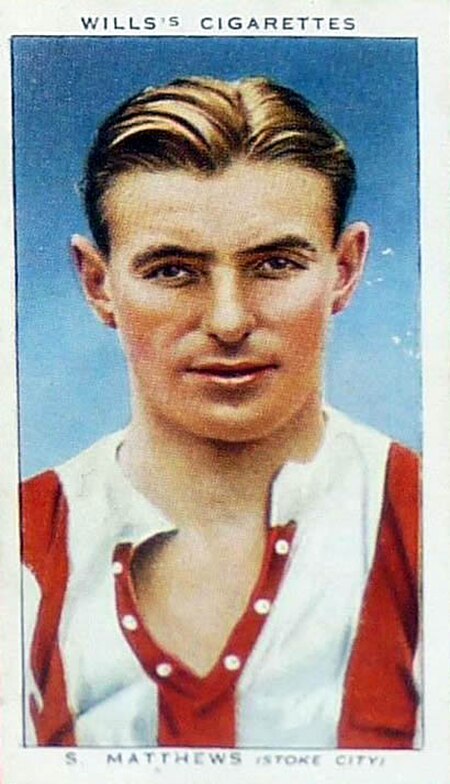
English footballer (1915–2000) For other people named Stanley Matthews, see Stanley Matthews (disambiguation). SirStanley MatthewsCBE Matthews with Blackpool, lifting his 1953 FA Cup final winner's medal to the sky, so that his deceased father could see it[1]Personal informationFull name Stanley Matthews[2]Date of birth (1915-02-01)1 February 1915[3]Place of birth Hanley, Stoke-on-Trent, England[4]Date of death 23 February 2000(2000-02-23) (aged 85)[3&#…

Questa voce o sezione sugli argomenti modelli e attori giapponesi non cita le fonti necessarie o quelle presenti sono insufficienti. Puoi migliorare questa voce aggiungendo citazioni da fonti attendibili secondo le linee guida sull'uso delle fonti. Segui i suggerimenti del progetto di riferimento. Karina Nose, 能瀬 香里奈 (Nose Karina?) (Nagoya, 21 febbraio 1984), è una modella e attrice giapponese, nota anche con il solo prenome Karina (香里奈?, Karina). Indice 1 Biografia 2 Filmo…

Dalam nama Tionghoa ini, nama keluarganya adalah Mao. Isaac MaoLahir毛向輝KebangsaanTiongkokAlmamaterUniversitas Jiao Tong ShanghaiBerkman Center for Internet and SocietyDikenal atasPerangkat lunak, SharismeSitus webisaacmao.com Isaac Mao (Hanzi sederhana: 毛向辉; Hanzi tradisional: 毛向輝; Pinyin: Máo Xiànghuī) adalah seorang arsitek perangkat lunak dan peneliti media sosial Tiongkok. Ia melakukan riset terhadap pemahaman sosial dan mengembangkan filsafat Sharisme. Prana…
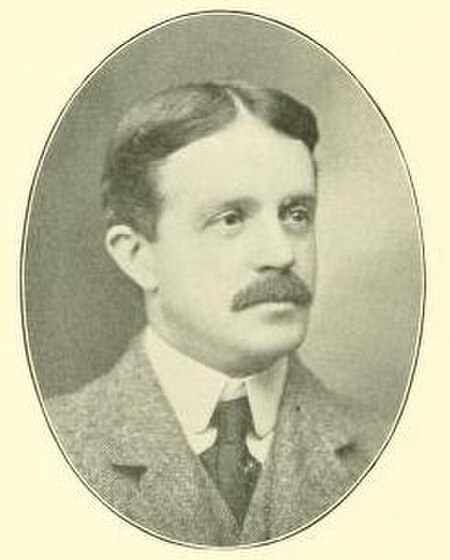
American politician George B. SloanGeorge B. Sloan (1903)Member of the New York State SenateIn office1886–1891Constituency21st DistrictMember of the New York State AssemblyIn office1874, 1876–1877, 1879Constituency1st District Personal detailsBornGeorge Beale Sloan(1831-06-20)June 20, 1831Oswego, New YorkDiedJuly 10, 1904 (1904-07-11) (aged 73)Oswego, New YorkResting placeRiverside CemeteryOccupationPolitician, businessman, bankerSignature George Beale Sloan (June 20, 1831 – July…

Department at Princeton University The Sharmin and Bijan Mossavar-Rahmani Center for Iran and Persian Gulf Studies logo The Sharmin and Bijan Mossavar-Rahmani Center for Iran and Persian Gulf Studies (Persian: مرکز شرمین و بیژن مصوّر رحمانی برای مطالعات ایران و خلیج فارس) is a study center department at Princeton University.[1] Its aim is to support teaching and research of Iran and Persian Gulf studies and to create and support productiv…

2002 video game Reign of Chaos and Third Great War redirect here. For the film, see The Bad Guys: Reign of Chaos. For the hypothetical future global conflict, see World War III. 2002 video gameWarcraft III: Reign of ChaosWarcraft III Orc box artDeveloper(s)Blizzard EntertainmentPublisher(s)Blizzard EntertainmentDirector(s)Frank Pearce Jr.Producer(s)Chris SigatyDesigner(s)Rob PardoArtist(s)Samwise DidierWriter(s)Chris MetzenComposer(s)Tracy W. BushDerek DukeGlenn StaffordSeriesWarcraftPlatform(s)…

Australian television news presenter Samantha ArmytageSamantha Armytage in 2012Born (1976-09-04) 4 September 1976 (age 47)Bolaro Station, Adaminaby, New South Wales, AustraliaEducation Kincoppal-Rose Bay[1] Charles Sturt University, Bathurst OccupationPrevious news presenter.Years active1999−presentEmployerSeven NetworkNotable credit(s)Seven 4.30 News presenter (2006–2012)Weekend Sunrise co-host (2007–2013) Sunrise co-host (2013–2021)SpouseRichard Lavender (m. 2020) Sam…
